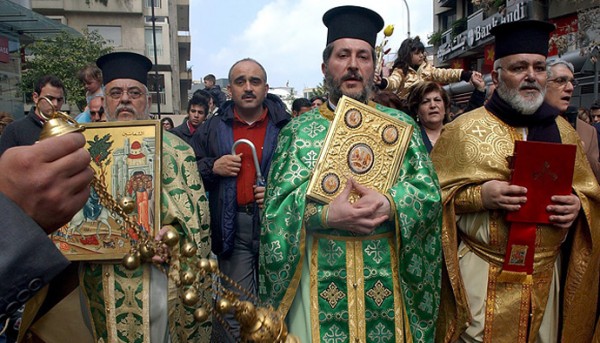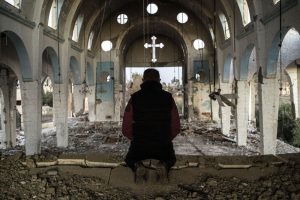This presentation was made by Dr. Najib E. Saliba at the annual dinner before Easter, sponsored by the Melkite Catholic Church of Worcester, Massachusetts, to be net needy Lebanese-Syrian children. Dr. Saliba is a Professor of Middle East History at Worcester State University, Worcester.
Those who follow current Middle East developments closely have probably reached the conclusion that Christianity and Islam are at war. This is certainly not the case. Christianity and Islam are not at war, but a fringe of “Muslims” who have gone astray from true Islam, do not speak for Islam, nor do they represent the majority of Muslims, are attacking Christians, as well as non-Christians, even Sunni Muslims who disagree with them. When Muhammad started his call to Islam and the worship of one God, Allah, early in the seventh century, A.D., the majority of Arabs in the Arabian Peninsula, except for a few Christian and Jewish tribes, were pagan worshipers. How did the prophet of Islam treat the Christians and Jews whom he encountered? He recognized them as the “People of the Book,” meaning possessors of a divine revelation, the same revelation Allah has sent to the Arabs through him. Prophet Muhammad gave Christians and Jews autonomy and protection of life and property in return for a poll tax called “jizya.” When he was challenged by the pagan Arabs to produce evidence for the existence of Allah, the one God, he referred them to the Jewish and Christian prophets who preceded him as evidence. He told them he was not bringing a new religion into the world, that he was walking in the footsteps of the Jewish and Christian prophets who preceded him. Allah has sent the same message to Jews and Christians before him; now it is the Arabs’ turn.
As the Muslims grew in number and strength, and Muslim-controlled territory expanded, the Prophet sent a letter to the monks of St. Catherine’s monastery in Sinai about 628 A.D., which opened as follows: “This is a message from Muhammad ibn ‘Abdallah, as a covenant to those who adopt Christianity, near and far, we are with them.” the letter went on to give the Christians safe conduct and security of life and property, including churches, monasteries, institutions, and movable or immovable possessions. Muhammed assured Christians that no coercion of any kind would befall them. This covenant, he said, was binding on all Muslims till the end of time.
Following Muhammed’s death in 632 A.D., his successors, the caliphs, began to expand territorially to the northeast and the northwest of the Arabian Peninsula. Iraq, Syria, and Egypt were predominantly Christian at that time. In dealing with the Christians of the new territories, the caliphs and army commanders followed the precedents set by Muhammad with the Christians of Arabia and Sinai. Thus, when Khalid ibn al-Walid laid siege to the city of Damascus in 635, he issued the following proclamation to the people of Damascus:
In the name of Allah, the compassionate, the merciful. This is what Khalid ibn al-Walid would grant to the inhabitants of Damascus if he enters therein: he promises to give them security for lives, property, and churches. Their city shall not be demolished, neither shall any Muslim be quartered in their houses. Thereunto, we give them the pact of Allah, and the protection of his Prophet, the caliphs, and the believers. So long as they pay the poll tax (jizya) nothing but good shall befall them.
Consequently, Damascus opened its gates to Khalid, and Khalid kept his word.
In addition to the above account, the Qur’an, the Muslim Holy Book, places Jesus and his mother Mary in a place of honor. There is a special Sura or chapter in the Qur’an devoted to Mary and Jesus. The Qur’an states that Jesus was sent as a miraculous sign and mercy to all the people. Furthermore, the Qur’an confirms the miracles of Jesus, and claims that Jesus spoke in the cradle saying, “God has made me blessed…so peace be upon me, the day I was born, the day that I die, and the day I am resurrected.” The Qur’an also mentions that the angels told Mary that “God has chosen you, and purified you, and has chosen you above the women of all nations.”
The above account tells us how authentic Islam treated the Christians. As a result, the inhabitants of Syria, Iraq, and Egypt welcomed the Arabs and helped them take over. Perhaps that was because the Arabs were no strangers to the lands north of Arabia. They had traded and interacted with their inhabitants for centuries. History does not tell us of any Christian uprising against Arab rule. On the other hand, the Christians of Syria and Egypt were estranged from Byzantine rule because of high taxes and religious persecution, as the Iraqi Christians were estranged from Persian rule.
If we are not aware of how Islam treated Christians in its formative period, we may reach the conclusion that Islam and Christianity have always been at war. Nothing could be further from the truth. Of course, what is happening currently to some Middle East Christians at the hands of ignorant militant jihadis is no less than a Greek tragedy. Islam, however, is not the culprit. It’s an erroneous interpretation of Islam on the part of a fringe of extremist Muslims who exploit periods of political unrest to spread religious fanaticism, intolerance, death and destruction.
History tells us that whenever there is a disruption of law and order Christians suffer. The fate of Iraqi Christians here is a classic example. The political destabilization of Iraq was the result of the U.S. occupation and the overthrow of Saddam Hussein in 2003. As a result, Iraqi central authority collapsed and a breakdown in law and order occurred. Either the U.S. did not have enough troops or it was unwilling to maintain public security. Everything in Baghdad became a free-for-all. The law of the jungle prevailed. The only government building that remained intact was the Ministry of Petroleum. Asked why the U.S. did not maintain law and order, our Secretary of Defense, Donald Rumsfeld, responded, “Let the people enjoy freedom!” In this atmosphere of chaos, Iraqi Christians became a target. At the time of the American invasion, Iraqi Christians numbered about a million to a million and a half. It is estimated that more than half of them fled Iraq. In 2006, some 20,000 Christians were driven out of Baghdad while our troops looked on. The city of Mosul in northern Iraq used to have “tens of thousands of Christians,” according to a recent issue of the Economist magazine. Perceived as pro-American, a number of them were killed in 2008, including the Chaldean Archbishop. Worse was yet to come! When the Islamic State occupied Mosul in 2014, Christian homes were marked with the letter “N”, meaning Naṣrani or “Christian” in Arabic. Christians were given the choice: convert to Islam, pay the “jizya,” or death. This is the first time Christians in the Arab Middle East were persecuted for their faith. Eventually some were killed, while others were driven out with only the clothes they had on. In 2014, the Islamic State declared that Mosul was free of Christians. In summary, Iraqi Christians were victims of foreign intervention, misinformation, miscalculation, and bad planning.
As for Syria, factors of destabilization are not dissimilar to those of Iraq. They include the Muslim Brotherhood, a domestic factor, working in full collaboration with foreign states, Arab and non-Arab alike. The Arab states include Saudi Arabia, Jordan and the Arab Gulf States. The non-Arab states include Turkey, the United States, Britain and France. The Muslim Brotherhood, still reeling from its defeat in Syria in the early 1980s, spearheaded political unrest in 2011 under the cover and churches pillaged, bells stolen, crosses removed and replaced by the black flag of the Islamic State. “We were horrified by what we saw,” said one town resident. “Everything was ruined, burned and plundered; … after the militants stormed the city, they stole all they could and destroyed the rest,” he continued.
The city of Aleppo was the home for some 220,000 Christians. About ten percent of them had fled by October 2013. More must have fled or been killed by now. About 80,000 Christians were forced out from the Homs area in central Syria. We learn from an article by Robert Fisk, a well-known authority on the Middle East, that 3,000 Christians from Qamishli, northeast Syria, had already emigrated by November, 2014, and the rest, about 5,000, were considering emigration, if they got the chance.
How do Middle East Christian hierarchs react to the flight of their flock? Christian hierarchs, of course, resent losing their parishioners to emigration, but cannot prevent them from doing so. In an impassioned plea issued by the Melkite Patriarch GREGORY III (Lahham) last September, the patriarch implored Syrian Christians not to leave. “Despite all your suffering,” the Patriarch said, “Stay! Be patient! Don’t emigrate. Stay for the church, your homeland, for Syria and its future!” About 80 leaders attended a conference of Christian leaders in ‘Amman, Jordan, in 2013. In their final statement, they were unanimous in rejecting any foreign intervention in Syria. The solution in the Middle East, the statement said, lay in building the democratic secular state, one that protects the personal rights and freedoms of all its citizens. Emigration was not the answer, they stressed, and they urged European states not to encourage Syrian Christians to emigrate.
The country, however, that has the largest concentration of Christians in the Middle East is Egypt: between 8 and 10 million. Despite their number, Egyptian Christians are no better off than the Iraqi or Syrian Christians. They have suffered from discrimination, abduction, attacks on monasteries and churches, and sometimes murder. Twenty-one Egyptian Christian workers in Libya were kidnapped in 2013 by extremists loyal to the Islamic State or ISIS, and butchered in 2015 on a Libyan beach. About the same time the Copts were kidnapped, St. Mark’s Cathedral in Cairo was attacked while a service was in progress. Two were killed, 80 wounded, and the service interrupted. Outside Cairo, especially in southern Egypt, attacks on priests and churches, and kidnappings for ransom, are not uncommon. Muhammad Mursi’s one-year presidency was the worst for the Copts. Following his overthrow, the Copts were blamed, and consequently, they suffered more attacks and abductions for ransom.
At this point, it is important to mention that some Muslim intellectuals in the U.S. and the Arab world condemned the Islamic State’s attacks on Arab Christians and other minorities, as well as the destruction of historical, religious, and cultural landmarks in Syria and Iraq at the hands of extremists. A good representative of these writers is ‘Azizah al-Hibri, a professor Emerita and a human rights lawyer. In an article entitled “Christian minorities: our trust betrayed,” ‘Azizah says,
A couple of weeks ago, the sleepy village of Ma’lula in Syria was attacked by a gang of armed terrorists. Several of its inhabitants were killed, its historic monasteries and churches pillaged, and its crosses were removed.
Ma’lula is one of the last places on earth that speak Aramaic, the language of Jesus. Its interfaith population has lived for over a thousand years peacefully together. These terrorists whether in Ma’lula, [or elsewhere], have committed atrocious crimes under the color of our religion. We Muslims, cannot stand in silent witness of their acts.
In a recent article in the Economist magazine the author states that, “the proportion of Middle Easterners who are Christian has dropped from 14% in 1910 to 4% today.” This is generally correct. The trend in the Christian population has been downward for a long time, and not necessarily because of violence or religious persecution. In Lebanon, for example, Christians outnumbered Muslims in the last official census taken by the French in 1932. Since then, all unofficial censuses make the Christians about 35% of the population at best. Many factors account for the diminishing Christian numbers. Christians are more likely to emigrate than Muslims. In the first wave of emigration from Greater Syria between 1880 and World War I, the immigrants were overwhelmingly Christian and from the Mount Lebanon area. There was no violence or religious persecution at the time in Mount Lebanon. On the contrary, people used to say, “Happy is he who has a goat’s resting place in Mount Lebanon.”
If so, why did the immigrants leave? They left basically for economic betterment. They heard that the streets in America were paved with gold. The idea of instant wealth drove many to emigrate. Perhaps the most important reason behind the declining number of Christians, relative to Muslims, is the fertility rate. Muslims have more children than Christians. Christians tend to emigrate; Muslims tend to stay. Sometimes, Muslim men marry more than one wife, and hence have more children.
Will the cradle of Christianity ultimately lose its Christians? It’s conceivable, but I hope not. History tells us that Arab Christians have survived past crises and are likely to survive the current and future ones as well. Arab Christians have always been a dynamic, vibrant and civilizing part of the population of the Arab world, past and present. In the past, following the Arab conquest of Iraq, Syria, Persia, and Egypt, Arab Christians translated Greek, Syriac, and Persian medical, scientific, astronomical, philosophical and humanistic knowledge to Arabic. The Arabs learned and assimilated this knowledge, and in turn produced a great civilization between the 9th and the 16th centuries that Europe could never match at the time. Spain, called Andalus by the Arabs, flourished materially and intellectually under Arab rule. When the Crusaders came to Syria at the end of the eleventh century, the medical knowledge they brought with them was so primitive in comparison to Arab medicine.
In modern times, Arab Christians spear-headed the Arab literary Renaissance and the revival of the Arabic language and humane learning. Butros Bustani founded the first national school in 1863. Archbishop Yusuf al-Dibs founded the Ḥikma school in 1875. The first Arabic printing press was introduced by the monastery of St. John in Khinsharah, Mount Lebanon, in 1734. The first Arabic newspaper was published by Rizkallah Ḥassoun in 1855. Khalil al-Khouri published Ḥadiqat al-Akhbar in 1857. Between 1870 and 1898, Arab Christians founded 17 newspapers and magazines in Lebanon and Egypt, including the newspapers al-Ahram, al-Muqaṭṭam, and the magazines al-Muqtaṭaf and al-Hilal. In politics, Najib ‘Azouri was the first to draw attention to the rising Zionist threat in Palestine in his book, the Awakening of the Arab Nation, published in French in 1904. George Antonius wrote the Arab Awakening, the first seminal work on Arab Nationalism. The only three secular political parties in Greater Syria were founded by Arab Christians. Finally, all the members of the Pen League, al-Rabiṭa al-Qalamiyya, in the United States, who contributed significantly to modern Arabi thought and literature, were Arab Christians.
In the final analysis, should the day come, God forbid, when Arab Christians become an extinct species in the cradle of Christianity, this will be a calamity of unparalleled proportions, not only to Arab Christians and Christianity, but also to Arab civilization, to Arab Muslims, and to diversity and pluralism in the Arab world!

















